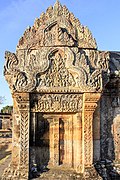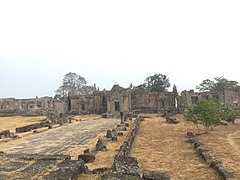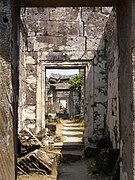Tempju ta' Preah Vihear

It-Tempju ta' Preah Vihear (bil-Khmer: ប្រាសាទព្រះវិហារ; Prasat Preah Vihear; bit-Tajlandiż: ปราสาทพระวิหาร; RTGS: Prasat Phra Wihan) huwa tempju Induista tal-qedem li nbena mill-Imperu Khmer u li jinsab fil-quċċata ta' rdum għoli 525 metru (1,722 pied) fil-Muntanji ta' Dângrêk, fil-provinċja ta' Preah Vihear tal-Kambodja.
Bħala binja ewlenija tal-ħajja spiritwali tal-imperu, it-Tempju ta' Preah Vihear ġie appoġġat u mmodifikat minn diversi rejiet suċċessivi u b'hekk fih elementi minn diversi stili arkitettoniċi. Huwa tempju mhux tas-soltu fost it-tempji Khmer għax inbena tul assi mit-Tramuntana għan-Nofsinhar, minflok bil-pjanta rettangolari tradizzjonali b'orjentazzjoni lejn il-Lvant. It-tempju jagħti ismu lill-provinċja ta' Preah Vihear tal-Kambodja li fiha jinsab, u jinsab qrib ukoll tal-Park Nazzjonali ta' Khao Phra Wihan, li jmiss miegħu fil-provinċja ta' Sisaket tat-Tajlandja, għalkemm mhuwiex aċċessibbli iktar mit-Tajlandja.
Fl-1962, wara tilwim fit-tul bejn il-Kambodja u t-Tajlandja dwar is-sjieda, il-Qorti Internazzjonali tal-Ġustizzja f'Den Haag ħarġet is-sentenza li t-tempju jinsab fil-Kambodja.[1] Fis-7 ta' Lulju 2008, it-Tempju ta' Preah Vihear tniżżel fil-lista tas-Siti ta' Wirt Dinji tal-UNESCO.[2][3] Dan wassal biex it-tilwim bejn il-Kambodja u t-Tajlandja jiskala rigward it-tempju, iżda fl-2011 ingħatat sentenza oħra tal-Qorti Internazzjonali tal-Ġustizzja favur il-Kambodja.
Pożizzjoni
[immodifika | immodifika s-sors]
It-tempju nbena fil-quċċata ta' Poy Tadi, irdum wieqaf fil-katina muntanjuża ta' Dângrêk li hija l-fruntiera naturali bejn il-Kambodja u t-Tajlandja. Is-sit huwa elenkat mill-Kambodja bħala li jinsab fil-villaġġ ta' Svay Chrum, il-komun ta' Kan Tout, fid-Distrett ta' Choam Khsant tal-Provinċja ta' Preah Vihear. Jinsab 140 kilometru minn Angkor Wat u 418 kilometru mill-belt kapitali Phnom Penh.
It-tempju ġie elenkat mit-Tajlandja bħala li jinsab fil-villaġġ ta' Bhumsrol tas-sottodistrett ta' Bueng Malu (li issa sar ħaġa waħda mas-sottodistrett ta' Sao Thong Chai), fid-distrett ta' Kantharalak tal-provinċja ta' Sisaket. Jinsab 110 kilometri mid-Distrett ta' Mueang Sisaket, fiċ-ċentru tal-provinċja ta' Sisaket. Fl-1962, il-Qorti Internazzjonali tal-Ġustizzja ħarġet sentenza li s-sjieda tal-binja tat-tempju kienet tal-Kambodja, għalkemm l-aċċess dirett għalih kien mit-Tajlandja, iżda mill-2015, l-uniku aċċess għas-sit huwa mill-Kambodja.
Sit
[immodifika | immodifika s-sors]Il-kumpless tat-tempju huwa estiż fuq 800 metru (2,600 pied) tul assi mit-Tramuntana għan-Nofsinhar, u jħares lejn il-pjanuri tat-Tramuntana, għalkemm fi ħdanhom hemm il-fruntiera internazzjonali bejn il-Kambodja u t-Tajlandja. Jikkonsisti minn mogħdija u taraġ li jitilgħu l-għolja sas-santwarju li jinsab fil-quċċata tal-irdum fin-naħa tan-Nofsinhar tal-kumpless (120 metru jew 390 pied 'il fuq min-naħa tat-Tramuntana tal-kumpless, 525 metru jew 1,722 pied 'il fuq mill-pjanura Kambodjana u 625 metru jew 2,051 pied 'il fuq mil-livell tal-baħar). Għalkemm din l-istruttura hija differenti ħafna mit-tempji fil-muntanji li hemm pereżempju f'Angkor, għandha l-istess funzjoni bħala rappreżentazzjoni stilizzata tal-Muntanja ta' Meru. L-approċċ lejn is-santwarju huwa mżejjen b'ħames gopuras (tradizzjonalment dawn huma numerati mis-santwarju 'l barra, għaldaqstant il-gopura numru ħamsa hija l-ewwel waħda li jaraw il-viżitaturi). Kull waħda mill-gopuras ta' qabel l-ispazji fil-beraħ hija aċċessibbli permezz ta' sett ta' taraġ u b'hekk jimmarkaw bidla fl-għoli. Il-gopuras jimblukkaw ukoll il-veduta tal-parti li jmiss tat-tempju, sakemm wieħed jgħaddi mid-daħla, u b'hekk impossibbli li wieħed jara l-kumpless kollu f'daqqa minn xi punt fuq l-art. Il-ħames gopura, bl-istil ta' Koh Ker, għad għandha traċċi ta' żebgħa ħamra li biha kienet imżejna, għalkemm is-saqaf bil-madum tagħha issa għeb għalkollox. Ir-raba' gopura hija iktar reċenti u tmur lura għall-perjodi ta' Khleang/Baphuon. Fuq in-naħa ta' barra tal-frontun tan-Nofsinhar tagħha, fiha "wieħed mill-kapulavuri ta' Preah Vihear" (Freeman, p. 162): rappreżentazzjoni taż-Żinglar tal-Baħar tal-Ħalib. It-tielet gopura hija l-ikbar u maġenbha hemm ukoll żewġ swali. Wieħed jasal għas-santwarju minn żewġ spazji fil-beraħ suċċessivi, u f'dak ta' barra hemm ukoll żewġ libreriji.
Isem
[immodifika | immodifika s-sors]
Prasat Preah Vihear huwa l-isem sħiħ magħmul mill-kliem Prasat, Preah, u Vihear, li jfissru "offerta reliġjuża tas-santwarju sagru". Bis-Sanskritu, prasat (प्रसाद; ប្រាសាទ) tfisser "offerta reliġjuża", li tista' titqies ukoll bħala sinonimu ta' "tempju" f'dan il-kuntest; preah (ព្រះ) tfisser "sagru" jew "maħbub"; u vihear (វិហារ), mill-kelma bis-Sanskritu vihara (विहार), tfisser "residenza" jew "santwarju" (l-istruttura ċentrali ta' tempju). Bil-Khmer, phnom (ភ្នំ) tfisser "muntanja", u l-Kambodjani xi kultant jirreferu għat-tempju bħala "Phnom Preah Vihear" (ភ្នំព្រះវិហារ). Dawn il-verżjonijiet tal-isem fihom konnotazzjonijiet politiċi u nazzjonali sinifikanti ħafna.
Imperu Khmer
[immodifika | immodifika s-sors]
Il-kostruzzjoni tal-ewwel tempju fis-sit bdiet fil-bidu tas-seklu 9. Kemm dak iż-żmien kif ukoll fis-sekli ta' wara, ġie ddedikat lill-alla tal-Induiżmu Xiva fil-manifestazzjonijiet tiegħu bħala l-allat tal-muntanji Sikharesvara u Bhadresvara. Madankollu, l-iżjed partijiet bikrin li għadhom jeżistu fit-tempju jmorru lura għall-perjodu ta' Koh Ker fil-bidu tas-seklu 10, meta l-belt kapitali tal-imperu kienet tinsab fil-belt tal-istess isem. Illum il-ġurnata, wieħed jista' jara elementi tal-istil ta' Banteay Srei tal-aħħar tas-seklu 10, iżda l-biċċa l-kbira tat-tempju nbena matul ir-renji tar-rejiet Khmer Suryavarman I (1006–1050) u Suryavarman II (1113–1150). Inċiżjoni li nstabet fit-tempju tipprovdi rendikont dettaljat ta' Suryavarman II jistudja r-ritwali sagri, jiċċelebra l-festivals reliġjużi, u jagħti d-doni, inkluż umbrelel bojod, skutelli tad-deheb u iljunfanti, lill-konsulent spiritwali tiegħu, ix-xwejjaħ Brahmin Divakarapandita. Dan tal-aħħar interessa ruħu fit-tempju, skont l-inċiżjoni, u bħala donazzjoni tah statwa tad-deheb ta' Xiva jiżfen magħruf bħala Nataraja. Fid-dawl tad-deklin tal-Induiżmu fir-reġjun, is-sit ġie kkonvertit għall-użu mill-Buddisti.
Storja moderna u tilwim dwar is-sjieda
[immodifika | immodifika s-sors]| Tempju ta' Preah Vihear (il-Kambodja vs it-Tajlandja) | |
|---|---|
| Qorti | Qorti Internazzjonali tal-Ġustizzja |
| Sentenza | il-15 ta' Ġunju 1962 |
| Storja tal-każ | |
| Azzjoni sussegwenti | Talba għal Interpretazzjoni tas-Sentenza tal-15 ta' Ġunju 1962 fil-Każ rigward it-Tempju ta' Preah Vihear (il-Kambodja vs it-Tajlandja) |
| Opinjonijiet dwar il-każ | |
| It-tempju jinsab fit-territorju tal-Kambodja; it-Tajlandja hija obbligata tirtira kwalunkwe qawwa militari jew tal-pulizija stazzjonati hemmhekk u tirritorna lill-Kambodja kwalunkwe oġġett li tneħħa mill-fdalijiet mill-1954. | |
Fiż-żminijiet moderni, it-Tempju ta' Preah Vihear reġa' ġie skopert u kien fil-mira ta' tilwima bejn it-Tajlandja u l-Kambodja wara li kisbet l-indipendenza. Din it-tilwima nqalgħet minħabba l-mapep differenti li kull naħa kienet tuża fid-delimitazzjoni nazzjonali tagħha. Fl-1904, is-Siam u l-awtoritajiet kolonjali Franċiżi li kienu qed imexxu fil-Kambodja ffurmaw kummissjoni konġunta biex tiddemarka fruntiera reċiproka li fil-biċċa l-kbira ssegwi l-mogħdija tal-ilma tal-katina muntanjuża ta' Dângrêk, u b'hekk it-Tempju ta' Preah Vihear ġie fuq in-naħa tat-Tajlandja. Franza, li kienet il-protettriċi tal-Kambodja dak iż-żmien, qablet mas-Siam fit-Trattat tal-1904 bejn Franza u s-Siam rigward il-fruntieri. Il-Kummissjoni Mħallta ġiet stabbilita fl-1905, u kellha twettaq id-delimitazzjoni bejn is-Siam u l-Kambodja. Fl-1907, wara xogħol ta' stħarriġ, l-uffiċjali Franċiżi fasslu mappa biex juru fejn jinsabu l-fruntieri. Il-Kambodja użat il-mappa ppubblikata mill-ġeografi Franċiżi fl-1907 (imsejħa "mappa tal-Anness I"), li kienet turi t-tempju fit-territorju tal-Kambodja, filwaqt li t-Tajlandja użat id-dispożizzjonijiet tat-Trattat tal-1904, li jiddikjaraw:
"Il-fruntiera bejn is-Siam u l-Kambodja tibda mix-xatt tax-xellug tal-Lag il-Kbir. Mill-bokka tax-xmara Stung Roluos, issegwi b'mod parallel minn dak il-punt lejn il-Lvant, sa ma tiltaqa' max-xmara Prek Kompong Tiam, imbagħad, lejn it-Tramuntana, tingħaqad mal-meridjan minn dak il-punt ta' lqugħ saħansitra tal-katina muntanjuża ta' Pnom Dang Rek. Minn hemm 'il quddiem issegwi l-korp tal-ilma bejn il-baċiri tax-xmara Nam Sen u tax-xmara Mekong fuq naħa, u tax-xmara Nam Moun min-naħa l-oħra, u tingħaqad mal-katina muntanjuża ta' Pnom Padang, u ssegwi l-quċċata tagħhom lejn il-Lvant sax-xmara Mekong. Lil hinn minn dak il-punt, ix-xmara Mekong tibqa' bħala l-fruntiera tar-Renju tas-Siam, f'konformità mal-Artikolu 1 tat-Trattat tat-3 ta' Ottubru 1893".
B'hekk it-tempju jidher bħala li jinsab fi ħdan territorju Tajlandiż.
Madankollu, il-mappa topografika li tirriżulta minn dan, li ntbagħtet lill-awtoritajiet Siamiżi u li ntużat fis-sentenza tal-1962 tal-Qorti Internazzjonali tal-Ġustizzja, turi li l-linja tiddevja kemxejn mill-korp tal-ilma mingħajr spjegazzjoni fl-inħawi ta' Preah Vihear, u b'hekk it-tempji jidhru li jinsabu fit-territorju tal-Kambodja.
Wara l-irtirar tat-truppi Franċiżi mill-Kambodja fl-1954, il-qawwiet Tajlandiżi okkupaw it-tempju biex jinfurzaw il-jedd tagħhom. Il-Kambodja pprotestat u fl-1959 appellat lill-Qorti Internazzjonali tal-Ġustizzja biex tiddikjara li t-tempju u l-inħawi tal-madwar jinsabu fit-territorju tal-Kambodja; il-każ sar kwistjoni politika taħraq fiż-żewġ pajjiżi. Ir-relazzjonijiet diplomatiċi waqfu ħesrem, u t-theddidiet tal-użu tal-forza tressqu miż-żewġ gvernijiet.
Il-proċedimenti tal-qorti ma ffukawx fuq il-kwistjonijiet tal-wirt kulturali jew fuq liema stat kien is-suċċessur tal-Imperu Khmer, iżda iktar fuq l-aċċettazzjoni fit-tul preżunta tas-Siam tal-mappa tal-1907. F'Den Haag argumenta favur il-Kambodja l-eks Segretarju tal-Istat tal-Istati Uniti Dean Acheson, filwaqt li t-tim legali tat-Tajlandja kien jinkludi eks avukat ġenerali Brittaniku, Sir Frank Soskice. Il-Kambodja kkontestat li l-mappa li turi li t-tempju jinsab fit-territorju Kambodjan kienet dokument awtoritattiv. It-Tajlandja argumentat li l-mappa ma kinitx valida u li ma kinitx dokument uffiċjali tal-kummissjoni dwar il-fruntieri, u li b'mod ċar kienet qed tikser il-prinċipju operattiv tal-kummissjoni li l-fruntiera ssegwi l-linja tal-korp tal-ilma, u b'hekk il-biċċa l-kbira tat-tempju jinsab fit-Tajlandja. Il-fatt li t-Tajlandja ma pprotestatx rigward il-mappa qabel, skont in-naħa Tajlandiża, kien minħabba li l-awtoritajiet Tajlandiżi fil-fatt kellhom il-pussess tat-tempju għal xi żmien, fid-dawl anke tad-diffikultà kbira li wieħed jitla' mill-għoljiet weqfin tan-naħa Kambodjana, jew sempliċement ma fehmux li l-mappa kienet żbaljata.
Sentenza tal-Qorti Internazzjonali tal-Ġustizzja
[immodifika | immodifika s-sors]Fil-15 ta' Ġunju 1962, il-Qorti Internazzjonali tal-Ġustizzja ddeċidiet b'vot ta' 9 bi 3 favur li t-tempju kien tal-Kambodja, li t-Tajlandja kienet obbligata tirtira t-truppi kollha stazzjonati hemmhekk, u b'vot ta' 7 b'5 favur li t-Tajlandja trid tirritorna l-antikitajiet bħall-iskulturi li kienet neħħiet mit-tempju. Il-mappa tal-Anness I ma obbligatx liż-żewġ partijiet peress li ma kinitx frott il-Kummissjoni Mħallta skont it-trattat. Madankollu, iż-żewġ partijiet adottaw il-mappa, u l-linja tad-demarkazzjoni fiha għaldaqstant kellha natura vinkolanti. Fid-deċiżjoni tagħha, il-qorti nnutat li f'iktar minn ħames deċennji wara li tfasslet il-mappa, l-awtoritajiet Siamiżi/Tajlandiżi ma oġġezzjonawx f'diversi fora internazzjonali għal din it-turija tal-pożizzjoni tat-tempju. Lanqas ma oġġezzjonaw meta uffiċjal kolonjali Franċiż laqa' lill-istudjuż Siamiż u figura tal-gvern il-Prinċep Damrong fit-tempju fl-1930 (possibbilment qabel ma t-Tajlandiżi indunaw li l-mappa kienet żbaljata). Skont il-prinċipju legali Qui tacet consentire videtur si loqui debuisset ac potuisset ("ma jiskot jitqies bħala li jaqbel"), il-qorti ddeċidiet li t-Tajlandja kienet aċċettat u bbenefikat minn partijiet oħra tat-trattat tal-fruntieri. Permezz ta' dawn l-atti u oħrajn, skontha t-Tajlandja kienet aċċettat il-mappa, u għaldaqstant il-Kambodja kienet sid it-tempju.
"Madankollu mid-dokumentazzjoni, kien ċar li l-mapep ġew ikkomunikati lill-gvern Siamiż bħala li jirrappreżentaw l-eżitu tal-ħidma tad-delimitazzjoni; ladarba ma kien hemm l-ebda reazzjoni min-naħa tal-awtoritajiet Siamiżi, la dak iż-żmien u lanqas għal bosta snin wara, iridu jitqiesu bħala aċċettati. Barra minn hekk, il-mapep ġew ikkomunikati lill-membri Siamiżi tal-Kummissjoni Mħallta, li ma qalu xejn, lill-Ministru Siamiż tal-Intern, il-Prinċep Damrong, li rringrazzja lill-Ministru Franċiż f'Bangkok talli tahomlu, u lill-gvernaturi provinċjali Siamiżi, li wħud minnhom kienu midħla ta' Preah Vihear. Ladarba l-awtoritajiet Siamiżi aċċettaw il-mappa tal-Anness I mingħajr investigazzjoni, issa ma setgħux isostnu li kien hemm xi żball li jxejjen ir-realtà tal-kunsens tagħhom. Il-gvern Siamiż u iktar 'il quddiem il-gvern Tajlandiż ma qajmu l-ebda kwistjoni dwar il-mappa tal-Anness I qabel in-negozjati mal-Kambodja f'Bangkok fl-1958. Iżda fl-1934–1935, stħarriġ kien stabbilixxa diverġenza bejn il-linja tal-mappa u l-linja reali tal-korp tal-ilma, u mapep oħra ġew prodotti li juru li t-tempju kien jinsab fit-Tajlandja. Minkejja dan, it-Tajlandja baqgħet tuża u tabilħaqq tippubblika mapep li juru li Preah Vihear kien jinsab fil-Kambodja. Barra minn hekk, matul in-negozjati għat-Trattati bejn il-Franċiżi u s-Siamiżi tal-1925 u tal-1937, li kkonfermaw il-fruntieri eżistenti, u fl-1947 f'Washington quddiem il-Kummissjoni ta' Konċiljazzjoni bejn il-Franċiżi u s-Siamiżi, it-Tajlandja kienet siekta. Għaldaqstant, it-Tajlandja tqieset li kienet aċċettat il-fruntiera fir-rigward ta' Preah Vihear kif imfassla fuq il-mappa, irrispettivament mir-rabta tagħha mal-linja tal-korp tal-ilma".
Madankollu, l-imħallef Awstraljan Sir Percy Spender kiteb nuqqas ta' qbil għall-minoranza fil-qorti, fejn indika li l-gvern Franċiż qatt ma semma l-aċċettazzjoni Tajlandiża, lanqas meta t-Tajlandja stazzjonat osservaturi militari fit-tempju fl-1949. Għall-kuntrarju, il-Franċiżi dejjem insistew li l-mappa tagħhom kienet korretta u li t-tempju kien jinsab fuq in-naħa tagħhom tal-korp tal-ilma naturali (li huwa ċar li mhux il-każ). It-Tajlandja kienet immodifikat il-mapep tagħha stess, li fl-opinjoni ta' Spender kien biżżejjed mingħajr l-ebda bżonn ta' protesta fir-rigward ta' Franza. Spender sostna:
Indipendentement mill-fatt jekk il-Kummissjoni Mħallta ddelimitatx jew le l-katina muntanjuża ta' Dangrek, fl-opinjoni tiegħi l-verità hi li l-linja tal-fruntiera fuq dik il-katina muntanjuża llum il-ġurnata hija l-linja tal-korp tal-ilma. Madankollu, il-qorti sostniet linja tal-fruntiera li mhijiex il-linja tal-korp tal-ilma, waħda li fiż-żona kritika tat-tempju hija kompletament differenti. Din hija ġġustifikata fl-applikazzjoni tal-kunċetti ta' rikonoxximent jew aċċettazzjoni. Bir-rispett kollu dovut lill-qorti, jien obbligat ngħid fl-opinjoni tiegħi, bħala riżultat ta' applikazzjoni ħażina ta' dawn il-kunċetti u estensjoni inammissibbli tagħhom, it-territorju u s-sovranità sussegwenti, kemm bit-trattat u kemm bid-deċiżjoni tal-korp maħtur skont it-trattat biex jiddetermina l-linja tal-fruntiera, huma tat-Tajlandja, għalkemm issa ġew assenjati lill-Kambodja.
It-Tajlandja rreaġixxiet b'rabja kbira. Ħabbret li kienet se tagħmel bojkott għal-laqgħat tal-Organizzazzjoni tat-Trattat tax-Xlokk tal-Asja, u l-uffiċjali Tajlandiżi sostnew li dan il-pass kien ta' protesta kontra preġudizzju tal-Istati Uniti favur il-Kambodja f'din it-tilwima. Bħala evidenza, l-uffiċjali Tajlandiżi kkwotaw ir-rwol ta' Acheson bħala l-avukat tal-Kambodja; il-gvern tal-Istati Uniti wieġeb li Acheson kien sempliċement qed jaġixxi bħala avukat privat imqabbad mill-Kambodja. Fit-Tajlandja saru dimostrazzjonijiet tal-massa, bħala protesta kontra d-deċiżjoni. Eventwalment it-Tajlandja ċediet u qablet li tirritorna s-sit lill-Kambodja. Minflok baxxew il-bandiera nazzjonali Tajlandiża li kienet tittajjar fit-tempju, is-suldati Tajlandiżi radmu l-bandiera fis-sit u neħħew l-arblu. L-arblu tqiegħed fuq l-irdum ta' Mor I Daeng fil-qrib, u għadu jintuża sal-lum. F'Jannar 1963, il-Kambodja formalment ħadet il-pussess tas-sit f'ċerimonja li attendew għaliha xi 1,000 ruħ, u ħafna minnhom kien ġew bil-mixi mill-irdum fuq in-naħa tal-Kambodja. Il-Prinċep Sihanouk, il-mexxej tal-Kambodja, tela' l-irdum f'inqas minn siegħa, u mbagħad għamel offerta lill-patrijiet Buddisti. Għamel ġest ta' konċiljazzjoni fiċ-ċerimonja, u ħabbar li t-Tajlandiżi kollha setgħu jżuru t-tempju mingħajr bżonn ta' viża, u li t-Tajlandja setgħet iżżomm kwalunkwe antikità li kienet ħadet mis-sit.
Gwerra ċivili
[immodifika | immodifika s-sors]Il-gwerra ċivili fil-Kambodja bdiet fl-1970; il-pożizzjoni tat-tempju fl-għoli fil-quċċata ta' rdum kienet tfisser li seta' jiġi difiż faċilment mill-puntidivista militari. Is-suldati li kienu leali għall-gvern ta' Lon Nol f'Phnom Penh baqgħu jżommu l-kontroll tiegħu ferm wara li l-pjanura sfat f'idejn il-forzi Komunisti.
Għalkemm il-Khmer Rouge kienu ħatfu lil Phnom Penh f'April 1975, is-suldati tal-Forzi Armati Nazzjonali Khmer f'Preah Vihear baqgħu jirreżistu wara l-kollass tar-Repubblika Khmer. Il-Khmer Rouge għamlu diversi tentattivi biex jaħtfu l-kontroll tat-tempju, u fl-aħħar irnexxielhom fit-22 ta' Mejju 1975 permezz ta' sparar lejn l-irdum, skalar, u attakki kontra d-difensuri, skont rapporti ta' uffiċjali Tajlandiżi ta' dak iż-żmien. Id-difensuri sempliċement qasmu l-fruntiera u arrendew quddiem l-awtoritajiet Tajlandiżi.
Il-gwerra reġgħet faqqgħet fil-Kambodja f'Diċembru 1978, meta l-armata Vjetnamita invadiet biex tegħleb lill-Khmer Rouge. It-truppi tal-Khmer Rouge rtiraw lejn iż-żoni tal-fruntiera. F'Jannar, jingħad li l-Vjetnamiti attakkaw lit-truppi tal-Khmer Rouge li kienet moħbija fit-tempju, iżda ma kienx hemm rapporti li kkawżaw xi ħsarat estensivi. Għadd kbir ta' refuġjati Kambodjani daħlu fit-Tajlandja wara l-invażjoni. It-taqbid bejn il-gwerrilji baqa' għaddej fil-Kambodja matul is-snin 80 u 90 tas-seklu 20, u xekkel l-aċċess għal Preah Vihear. It-tempju reġa' nfetaħ għall-pubbliku għal żmien qasir fl-1992, iżda reġa' ġie okkupat is-sena ta' wara mill-ġellieda tal-Khmer Rouge. F'Diċembru 1998, fit-tempju saru n-negozjati li permezz tagħhom diversi mijiet ta' suldati tal-Khmer Rouge, li jingħad li kienu l-aħħar qawwa ta' gwerrilja sinifikanti, qablu li jarrendu quddiem il-gvern ta' Phnom Penh.
It-tempju nfetaħ mill-ġdid għall-viżitaturi min-naħa Tajlandiża fl-aħħar tal-1998; il-Kambodja lestiet il-kostruzzjoni ta' triq ta' aċċess għal fuq l-irdum fl-2003.
Tkeċċija tar-refuġjati mill-Kambodja
[immodifika | immodifika s-sors]Fit-12 ta' Ġunju 1979, il-gvern tal-Ġeneral Kriangsak Chomanan, li kien kiseb il-poter fit-Tajlandja permezz ta' kolp militari, informa l-ambaxxati barranin f'Bangkok li kien se jkeċċi għadd kbir ta' refuġjati Kambodjani. Huwa ppermetta lill-gvernijiet tal-Istati Uniti, ta' Franza u tal-Awstralja jagħżlu 1,200 refuġjat biex jirrilokaw fil-pajjiżi tagħhom. Lionel Rosenblatt, koordinatur tar-refuġjati tal-ambaxxata Amerikana, Yvette Pierpaoli, negozjanta Franċiża f'Bangkok, u rappreżentanti tal-gvernijiet tal-Awstralja u ta' Franza ħaffu lejn il-fruntiera biex jagħżlu r-refuġjati billejl. Fi tliet sigħat frenetiċi, il-barranin għażlu 1,200 refuġjat għar-rilokazzjoni minn fost l-eluf miżmuma mis-suldati Tajlandiżi fit-tempju Buddist ta' Wat Ko (Wat Chana Chaisri), fir-raħal ta' Aranyaprathet, u għabbewhom fuq karozzi tal-linja li kellhom jittrasportawhom lejn Bangkok. Il-bqija tar-refuġjati ttieħdu lejn destinazzjoni mhux magħrufa. Iktar 'il quddiem ġie skopert li r-refuġjati kienu nġabru minn bosta postijiet u ntbagħtu lejn Preah Vihear. Uffiċjal tal-ambaxxata Amerikana qagħad taħt siġra tul it-triq imħarbta li kienet twassal sat-tempju, jgħodd il-karozzi tal-linja, u stima li madwar 42,000 Kambodjan ittieħdu lejn it-tempju.
It-Tempju ta' Preah Vihear jinsab fil-quċċata ta' rdum għoli 2,000 pied fuq il-pjanuri tal-Kambodja. Ir-refuġjati tniżżlu mill-karozzi tal-linja u ġew imbuttati 'l isfel. Wieħed minnhom sostna "Ma kien hemm l-ebda mogħdija. L-unika mod biex ninżlu kien minn irdum għal isfel. Xi nies staħbew fil-quċċata tal-muntanja u baqgħu ħajjin. Oħrajn sparawlhom jew imbuttawhom għal isfel. Il-biċċa l-kbira tan-nies bdew jixxabtu 'l isfel permezz ta' vinji użati bħala ħbula. Huma rabtu lit-tfal tagħhom ma' daharhom jew ma' sidirhom. Huma u neżlin, is-suldati waddbulhom ġebel kbir".[4]
Il-Kummissarju Għoli għar-Refuġjati tan-Nazzjonijiet Uniti iktar 'il quddiem stima li saħansitra 3,000 Kambodjan kienu nqatlu u 7,000 ruħ oħra mhux magħruf x'sar minnhom. Milli jidher l-objettiv il-Ġeneral Kriangsak fl-operazzjoni brutali tiegħu kienet li juri lill-komunità internazzjonali li l-gvern tiegħu ma kienx se jġorr waħdu l-piż ta' mijiet ta' eluf ta' refuġjati Kambodjani. Jekk dan kien il-każ, irnexxa. Fit-tnax-il sena ta' wara, il-pajjiżi tan-NU u tal-Punent ħallsu għaż-żamma tar-refuġjati Kambodjani fit-Tajlandja, eluf ġew rilokati f'pajjiżi oħra, u nstabu modi kif il-Kambodjani setgħu jirritornaw f'pajjiżhom stess b'mod sikur.
Sit ta' Wirt Dinji
[immodifika | immodifika s-sors]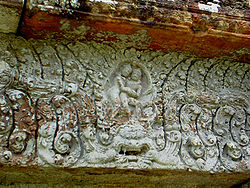
Fit-8 ta' Lulju 2008, il-Kumitat tal-Wirt Dinji ddeċieda li jżid it-Tempju ta' Preah Vihear, flimkien ma' 26 sit ieħor fil-lista tas-Siti ta' Wirt Dinji tal-UNESCO, minkejja diversi protesti mit-Tajlandja, peress li l-mappa kienet timplika s-sjieda Kambodjana tal-art ta' madwar it-tempju.[2] Ladarba l-proċess tat-tniżżil fil-lista kien beda, il-Kambodja ħabbret li beħsiebha tapplika biex is-sit jitniżżel fil-lista tal-UNESCO. It-Tajlandja pprotestat li kellu jkun sforz konġunt, u l-UNESCO ddifferiet id-dibattitu fil-laqgħa tagħha tal-2007. Wara, kemm il-Kambodja kif ukoll it-Tajlandja laħqu qbil li t-Tempju ta' Preah Vihear kellu "valur universali straordinarju" u kien jistħoqqlu jitniżżel fil-lista tas-Siti ta' Wirt Dinji tal-UNESCO mill-iktar fis. Iż-żewġ nazzjonijiet qablu li l-Kambodja kellha tipproponi s-sit b'mod formali fit-32 sessjoni tal-Kumitat tal-Wirt Dinji fl-2008, bl-appoġġ attiv tat-Tajlandja. Dan wassal għat-tfassil mill-ġdid tal-mappa tal-inħawi, u tniżżel biss it-tempju u l-inħawi tal-madwar tiegħu. Madankollu, l-oppożizzjoni politika tat-Tajlandja nediet attakk kontra dan il-pjan rivedut. Bħala rispons għall-pressjoni politika domestika, il-gvern Tajlandiż irtira l-appoġġ formali tiegħu biex it-Tempju ta' Preah Vihear jitniżżel bħala Sit ta' Wirt Dinji tal-UNESCO. Il-Kambodja kompliet bl-applikazzjoni, u minkejja l-protesti uffiċjali Tajlandiżi, irnexxiet fis-7 ta' Lulju 2008.[2]
Il-valur universali straordinarju tas-sit ġie rrikonoxxut abbażi ta' kriterju wieħed tal-għażla tal-UNESCO: il-kriterju (i) "Rappreżentazzjoni ta' kapulavur frott il-kreattività tal-bniedem".[2]
Tilwim dwar is-sjieda mill-2008
[immodifika | immodifika s-sors]
Il-kunflitt bejn il-Kambodja u t-Tajlandja fuq l-art ta' madwar is-sit wassal għal tifqigħat perjodiċi ta' vjolenza. Taqbida militari partikolari seħħet f'Ottubru 2008. F'April 2009, 66 ħaġra fit-tempju allegatament ġarrbu ħsarat minn suldati Tajlandiżi li sparaw tiri minn naħa għall-oħra tal-fruntiera. Fi Frar 2010, il-gvern tal-Kambodja ressaq ittra formali ta' lment mal-Google Maps peress li l-korp tal-ilma naturali ġie muri bħala fruntiera internazzjonali minflok il-linja murija fil-mappa Franċiża tal-1907 użata mill-Qorti Internazzjonali tal-Ġustizzja fl-1962.

Fi Frar 2011, meta l-uffiċjali Tajlandiżi kienu fil-Kambodja biex jinnegozjaw id-diżgwid, inqala' l-ġlied bejn it-truppi Tajlandiżi u Kambodjani, li rriżulta f'nies midruba u mwiet fiż-żewġ naħat. Matul il-kunflitt kien hemm ukoll bumbardamenti bl-artillerija. Il-gvern Kambodjan sostna li t-tempju ġarrab xi ħsarat. Madankollu, missjoni tal-UNESCO lejn is-sit biex jiġi ddeterminat x'ħsara saret indikat li l-qerda kienet frott tiri ta' armi tan-nar miż-żewġ naħat. Mill-4 ta' Frar 2011, iż-żewġ naħat użaw l-artillerija kontra xulxin, u t-tnejn taw il-ħtija lil xulxin għall-bidu tal-vjolenza. Fil-5 ta' Frar, f'ittra formali lin-NU, il-Kambodja lmentat li "l-azzjonijiet militari Tajlandiżi reċenti jiksru l-Ftehim ta' Paċi ta' Pariġi tal-1991, il-Karta tan-NU u s-sentenza tal-1962 tal-Qorti Internazzjonali tal-Ġustizzja". Fis-6 ta' Frar, il-gvern Kambodjan sostna li t-tempju ġarrab xi ħsarat. Il-kmandant militari tal-Kambodja sostna li "sezzjoni tat-Tempju ta' Preah Vihear iġġarrfet bħala riżultat dirett tal-bumbardament Tajlandiż bl-artillerija". Madankollu, is-sorsi Tajlandiżi semmew biss li saret ftit ħsara, u li s-suldati Kambodjani sparaw minn ġot-tempju. L-ASEAN, li huma membri tagħha ż-żewġ naħat, offriet li sservi bħala medjatur. Madankollu, it-Tajlandja insistiet li diskussjonijiet bilaterali setgħu jsolvu l-kwistjoni aħjar. Fil-5 ta' Frar, l-Alleanza tal-Poplu għad-Demokrazija tal-Lemin sejħet għar-riżenja tal-Prim Ministru Abhisit Vejjajiva għax "naqas milli jiddefendi s-sovranità tan-nazzjon".
Il-Kumitat tal-Wirt Dinji tal-UNESCO li ltaqa' f'Pariġi f'Ġunju 2011 qabel li jaċċetta l-proposta ta' ġestjoni tal-Kambodja għat-tempju. Bħala konsegwenza, it-Tajlandja rtirat mill-avveniment, u r-rappreżentat tat-Tajlandja spjega, "Qed nirtiraw biex nuru li ma naqblu ma l-ebda deċiżjoni minn din il-laqgħa". Wara talba mill-Kambodja fi Frar 2011 biex il-qawwiet Tajlandiżi jiġu ordnati jitilqu mill-inħawi, l-imħallfin tal-Qorti Internazzjonali tal-Ġustizzja, b'vot ta' 11–5, ordnaw liż-żewġ pajjiżi biex jirtiraw minnufih il-qawwiet militari tagħhom, u imponew iktar restrizzjonijiet fuq il-forzi tal-pulizija tagħhom. Il-qorti sostniet li din l-ordni ma kienet se tippreġudika l-ebda deċiżjoni finali dwar fejn kellha tiġi stabbilita l-fruntiera bejn it-Tajlandja u l-Kambodja. Abhisit Vejjajiva qal li s-suldati Tajlandiżi ma kinux se jitilqu mill-inħawi sakemm iż-żewġ pajjiżi jaqblu fuq l-irtirar reċiproku. Huwa qal li "kollox jiddependi fuq li ż-żewġ naħat jiltaqgħu u jitkellmu flimkien", donnu b'suġġeriment li kumitat konġunt tal-fruntiera eżistenti jkun iktar xieraq biex jiġi ppjanat l-irtirar konġunt. Fil-11 ta' Novembru 2013 il-Qorti Internazzjonali tal-Ġustizzja ddeċidiet li l-art ta' madwar it-tempju fil-Lvant u fil-Punent kienet tal-Kambodja (wara li kien diġà ntlaħaq qbil li n-Nofsinhar kienet tal-Kambodja u t-Tramuntana tat-Tajlandja), u li kull forza tas-sigurtà Tajlandiża fl-inħawi kellha tirtira.
Arkitettura
[immodifika | immodifika s-sors]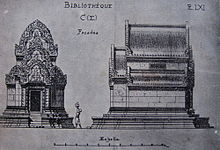
Pjanta
[immodifika | immodifika s-sors]Settijiet kbar tat-taraġ u triq twila bil-pilastri jagħtu għall-gopura tal-ewwel tliet livelli tal-muntanja. Hemm balavostri bin-nāga bejn it-tielet, ir-raba' u l-ogħla livell. Hemmhekk, il-galleriji u l-kolonnati jiddefinixxu ż-żoni għaċ-ċerimonji u għar-ritwali reliġjużi li jsiru fis-santwarju prinċipali li fih il-linga u fil-madwar.
Materjali
[immodifika | immodifika s-sors]
Il-ġebel ramli griż u isfar li ntuża għall-kostruzzjoni tat-Tempju ta' Preah Vihear kien disponibbli lokalment. L-injam kien jintuża b'mod estensiv għall-kostruzzjoni ta' riffieda għas-saqaf tat-tempju, li mbagħad kien jitgħatta bil-madum tat-terrakotta. Il-brikks, minkejja d-daqs żgħir tagħhom, kienu jintużaw minflok ix-xorok kbar tal-ġebel għall-kostruzzjoni tal-ħnejjiet kbar. Kien iktar faċli li jintużaw il-brikks għax jeħlu ma' xulxin faċilment bit-tkaħħil u iktar kumpatti u solidi mix-xorok tal-ġebel. Il-blokok tal-ġebel ramli li ntużaw għall-kostruzzjoni tat-torri prinċipali huma tassew kbar u jiżnu mhux inqas minn ħames tunnellati. Diversi minnhom fihom toqob li kienu jintużaw biex jiġu olzati.
Inċiżjonijiet
[immodifika | immodifika s-sors]Fit-Tempju ta' Preah Vihear instabu diversi inċiżjonijiet, u l-iżjed interessanti huma miġbura fil-qosor hawnhekk.
- K.383: magħrufa bħala l-Istele ta' Preah Vihear, jew l-Istele ta' Divakara, din l-inċiżjoni saret bis-Sanskritu u bil-Khmer, x'aktarx bejn l-1119 u l-1121 W.K. Tirrakkonta, skont l-ordni ta' Suryavarman II, il-ħajja tal-guru rjali Divakara u kif serva taħt ħames rejiet Khmer (Udayadiyavarman II, Harshavarman III, Jayavarman VI, Dharanindravarman I u Suryaman II), li tah bosta doni, kemm għalih kif ukoll bħala donazzjoni f'ismu lit-tempji. Bejn l-ewwel u t-tieni deċennju tas-seklu 12, Divakara ġie mistoqsi minn Suryavarman II biex imur fuq pellegrinaġġ lejn it-tempji u joffri d-doni, jippresjedi s-sagrifiċċji ritwali, u jwettaq xogħlijiet ta' titjib u ta' tiswija. Fit-Tempju ta' Preah Vihear, Divakara offra oġġetti prezzjużi lil Shikhareshvara (l-alla prinċipali tat-tempju), bħal statwa, x'aktarx tad-deheb, ta' Xiva jiżfen. Huwa żied dais tad-deheb ingastata bil-ħaġar prezzjuż, kesa l-art tat-tempju bi plakek tal-bronż, u żejjen il-ħitan bi pjanċi ta' metalli prezzjużi. Huwa ordna li t-torrijiet, l-ispazji fil-beraħ u d-daħla prinċipali jiġu mżejna mill-ġdid kull sena. Huwa ħallas ukoll lil dawk kollha li ħadmu fit-tempju. Din l-inċiżjoni hija mnaqqxa fuq stele li tinsab fi ħdan il-mandapa.
- K.380: din l-inċiżjoni tinsab fuq iż-żewġ naħat tad-daħla tan-Nofsinhar tal-gopura tar-raba' livell. Miktuba bis-Sanskritu u bil-Khmer, x'aktarx bejn l-1038 u l-1049, tirrakkonta l-istorja importanti dwar it-Tempju ta' Preah Vihear. Tirrakkonta wkoll il-ġrajja ta' persunaġġ lokali, Sukarman, li wettaq id-dmirijiet ta' reġistratur tas-santwarju u ħa ħsieb l-arkivji tar-renju. Barra minn hekk issemmi digriet irjali li kien jirrikjedi lil ċertu persuni jieħdu ġurament ta' lealtà lejn Shikhareshvara.
- K.381: din l-inċiżjoni ġiet skolpita mal-koxxa tan-Nofsinhar tal-portiku tal-palazz tal-Lvant, fit-tielet livell. Miktuba bis-Sanskritu u bil-Khmer matul l-1024, tirrakkonta l-ġrajja ta' Tapasvindra-pandita, il-kap ta' eremitaġġ, li ġie mistoqsi jiddisponi preżentazzjoni favur Shikhareshvara.
- K.382: din l-inċiżjoni tnaqqxet fuq pilastru u meta nstabet kienet ġarrbet ħsarat estensivi quddiem is-santwarju ċentrali u iktar 'il quddiem ittieħdet lejn il-Mużew Nazzjonali ta' Bangkok fit-Tajlandja. Ġiet inċiża fl-1047 u tirreferi għal Suryavarman I, li kkummisjona l-inċiżjoni, iżda ma tantx fiha informazzjoni importanti dwar it-Tempju ta' Preah Vihear.
Taraġ tal-muntanja
[immodifika | immodifika s-sors]Meta l-viżitaturi jgħaddu mid-daħla moderna tat-tempju, iridu jiffaċċjaw sett wieqaf ta' 163 tarġa magħmula minn ħaġriet kbar, li bosta minnhom tħaffru direttament fil-wiċċ tal-blat. Is-sett tat-taraġ huwa wiesa' 8 metri u twil 78.5 metru. Oriġinarjament fuq kull naħa kien hemm ringieli ta' statwi ta' iljuni, għalkemm ma tantx fadal minnhom, qrib id-daħla moderna. Fl-aħħar 27 metru, it-taraġ jidjieq għal wisa' ta' 4 metri biss u maġenbu hemm seba' terrazzi żgħar fuq kull naħa, li fl-imgħoddi kienu mżejna bi statwi ta' iljuni. Id-diffikultà biex wieħed jitla' t-taraġ tissimbolizza l-mogħdija diffiċli tal-fidi meħtieġa biex wieħed jasal sad-dinja sagra tal-allat.
Ġibjun ta' ras l-iljun
[immodifika | immodifika s-sors]Bejn il-gopura IV u III, xi 50 metru lejn il-Lvant tat-tieni triq bil-pilastri, hemm ġibjun paviment bil-ġebel, ta' 9.4 metri fuq kull naħa. Kull naħa tal-ġibjun fiha 12-il tarġa, kull waħda għolja bejn 20 u 25 ċentimetru. Qrib dan il-ġibjun żgħir, hemm bażi kwadra tal-brikks ta' 6 metri fuq kull naħa. X'aktarx li din kienet tintuża bħala l-pedestall għal statwa jew kostruzzjoni żgħira magħmula b'materjali li jispiċċaw fix-xejn maż-żmien, u dan jissuġġerixxi użu ritwali ta' dan il-ġibjun żgħir. Skont rapporti preċedenti, fuq in-naħa tan-Nofsinhar ta' din il-vaska kien hemm ras tal-ġebel ta' iljun bi żbokk tal-ilma li kien joħroġ minn ħalqu. Kien ikun viżibbli biss meta l-livell tal-ilma kien ikun baxx ħafna. Din ir-ras ma għadhiex fis-sit, u mhux magħruf x'sar minnha.
Gallerija
[immodifika | immodifika s-sors]Referenzi
[immodifika | immodifika s-sors]- ^ Cambodia (bl-Ingliż). Central Intelligence Agency. 2024-10-15. Miġbur 2024-10-18.
- ^ a b ċ d "Temple of Preah Vihear - UNESCO". whc.unesco.org. Miġbur 2024-10-18.
- ^ "900-year-old temple on disputed Thai-Cambodia border named world heritage site - International Herald Tribune". web.archive.org. 2009-02-10. Arkivjat mill-oriġinal fl-2009-02-10. Miġbur 2024-10-18.Manutenzjoni CS1: BOT: url-oriġinali status mhux magħruf (link)
- ^ Thompson, 176.


